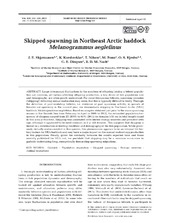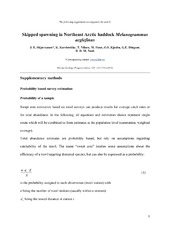| dc.description.abstract | Large interannual fluctuations in the numbers of offspring joining a teleost population are common, yet factors affecting offspring production, a key driver of fish population size and demography, are often poorly understood. For some iteroparous teleosts, spawning omission (‘skipping’) following sexual maturation may occur, but this is typically difficult to verify. Through the detection of post-ovulatory follicles, i.e. evidence of past spawning activity, in gonads of females not spawning in the current year, we demonstrate skipping in Northeast Arctic (NEA) haddock Melanogrammus aeglefinus. Based on samples obtained just prior to the main spawning season in the Barents Sea from February to April in 2009 to 2012, the estimated population frequency of skippers ranged from 23 (2009) to 64% (2011) for females ≥35 cm in total length found in this area at this time. Skipping was associated with limited energy reserves and persisted with age, although it appeared to be most common in 5 yr old females. This suggests that skipping is linked to a combination of feeding condition and demography of the fish population. While previously virtually undocumented in this species, this phenomenon appears to be an integral life history feature for NEA haddock and may have a major impact on the annual realised egg production in this population. Finally, given the similarity between the results reported here and those recently published for NEA cod, we postulate that skipping may be a common occurrence in gadoids undertaking long, energetically demanding spawning migrations. | en_US |


